Examination and Treatment of the Foot and Ankle
Learn something now! - Watch the Online CEU Course Trailer

All Access Online CEU for PT, PTA and OT for $189
BEST VALUE - Includes this course and all our online courses
Subscribe Todaytheaters Purchase Now, Instant Online Course Access
Examination and Treatment of the Foot and Ankle
$175.00
- CE Hours: 12.0 hrs, 1.2 CEU
- Delivered: Online
- Instant Online Access to Course Material and Videos for 365 days, Online Test, 90 page Downloadable PDF manual and Printable Course Certificate with State Specific CEU approval
- No auto-renewal for this option
All Access Online CEU for PT, PTA and OT
$189
All Access Online CEU for PT, PTA and OT Subscription
1 Year Access with Annual Renewal
State specific course completion certificates.
Chat support
Prices are in US dollars- 12 months of access to all online ceu courses, course tests and state approval certificates.
- Meet all your CE requirements. Pre-approved for PT, PTAs in AK, AL, AZ, CA, CO, CT, DC, DE, GA, HI, IA, ID, IL, IN, KS, MA, ME, MI, MO, MS, MT, NC, ND, NE, NH, NM, NV, NY, OR, PA, RI, SC, SD, TN, TX, UT, VA, VT, WA, WI, and WY.
- AOTA approved.
- Designed for Physical Therapists, Occupational Therapists, Athletic Trainers and Assistants.
- Access to future courses and content.
- Start, stop and resume, right where you left off in a course.
- Real patient interviews.
- Medical expert contributors.
- 3D anatomy and medical illustrations.
- Easy to use learning system for fast access to your courses.
- Award winning content.
- Top instructors teaching evidence based skills and techniques.
Why should a physical therapist, or athletic trainer take this Foot and Ankle Continuing Education Course?
The runner’s feet are exposed to repetitive pounding and are prone to foot pain, tendinitis, plantar fasciitis, and stress fractures. You don’t have to be a runner to experience a foot injury. Faulty biomechanics, improper shoe wear, and musculoskeletal dysfunction can all contribute to foot injuries. Physical therapists and Athletic trainers skilled in biomechanical assessment and movement analysis identify underlying causes of foot pain and develop comprehensive programs to improve function and decrease pain.
This course provides a step by step process for a comprehensive, evidence based, examination of the foot and ankle in order to develop and deliver an optimal individualized treatment program for a patient’s specific foot and ankle dysfunction.
Rehab clinical tools instructed in this foot and ankle rehabilitation course to enhance your functional outcomes.
- A methodical approach that provides assessment of lower extremity function
- Differential diagnosis to rule out such diagnoses as fat pad atrophy, lateral plantar nerve entrapment, plantar fasciitis and heel pain syndrome
- Foot and ankle treatments such as soft tissue and joint mobilizations, neuromuscular re-education, eccentric strengthening, and functional training activities are demonstrated
Specific instruction that will enhance your understanding and ability to deliver better patient care.
- Demonstration of a thorough biomechanical screen and progression into a full evaluation of the foot and ankle
- Goniometric measurements and interpretation of findings
- Ankle joint mobilization and manual muscle testing form the foundation of treatment
- Progressive exercise programs to improve strength, coordination and mobility
Features unique to this foot and ankle rehabilitation CE Course.
- Dynamic balance and orthotic functionality along with orthotic casting techniques
Professional Accreditation
This is an intermediate level course applicable for PT, PTA, AT. Physical Therapy Accreditation: For specific state information, use the accreditation verification menu and select your state of license. Athletic Trainers: BOC provider #P2047, category A. This course has not been submitted for Evidence-Based BOC approval..
fact_check Accreditation Verification
Online CEU Course for PT, PTA, OT State Accreditation
Learn from the Expert Joshua Bailey PT, DPT, OCS, CSCS, CPed
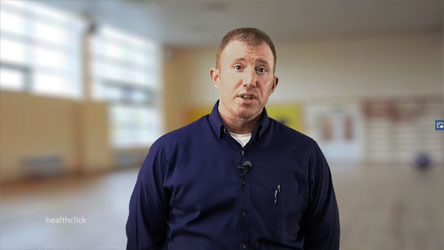
Joshua Bailey PT, DPT, OCS, CSCS, CPed, completed his MPT and DPT degrees at Shenandoah University. He is a certified strength and conditioning specialist from the NSCA as well as an orthopedic clinical specialist from the APTA. He is the President and Chief Executive Officer of Rehabilitation Associates of Central Virginia, an 11 site orthopedic physical therapy center, in Lynchburg, Virginia, where he practices managing foot and ankle cases. Dr. Bailey is also the Director of the Rehabilitation Associates of Central Virginia Foot and Ankle Specialty Team. Dr. Bailey works with a wide variety of patients including athletes, officials and referees in the NFL, NBA, WNBA, Major League Baseball, ACC, Big South Conference, and the Big East Conference. He is an adjunct faculty member with Liberty University, Lynchburg College Doctoral Physical Therapy program, and The Jackson Clinics Orthopedic Residency. He acts as a consultant for foot and ankle injuries for several Division I athletic programs as well. He has lectured in many forums on foot and ankle since 1997 on topics including pre and post-surgical management, manual therapy of the foot and ankle, differential diagnosis of foot and ankle disorders, as well as foot orthoses fabrication and modification.
Course Objectives

Upon successful completion of this course the participant will be able to:
- Identify the important components to performing and interpreting the findings of the biomechanical screen and determine if a foot evaluation is necessary.
- Utilize goniometric skills to measure tibial angle, axis of inclination of the subtalar articulation, inversion, eversion, dorsiflexion in STJN and gross dorsiflexion.
- Perform open chain muscle testing and accessory motion of the foot and ankle.
- Identify the weak musculature of the foot and ankle while performing manual muscle testing.
- Properly assess accessory motion of the longitudinal midtarsal joint, oblique metatarsal joint axis and the midtarsal joint.
- Identify techniques to utilize to perform a differential diagnosis exam to identify plantar fasciitis, fasciosis, fat pad atrophy, entrapment of the first branch of the lateral nerve and other causes of heel pain by utilizing hands on skills and testing.
- Develop a comprehensive treatment program utilizing open and closed chain stretching , exercises, manual therapy and orthotic fabrication
- Discuss how to perform an orthotic assessment and utilize a foam crush box to fabricate an appropriate orthotic.
- Perform an evidence based research review of current articles and utilize the information in developing your assessment and treatment plan.
Introduction and overview of why a biomechanical examination is so crucial
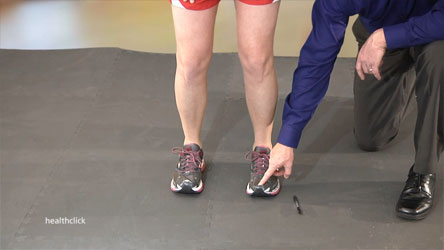
- Why you should perform a biomechanical screen
- What to expect from this training program
- Maximizing your understanding of the techniques and the value of hands on training
Biomechanical Screening of the Lower Extremity - Highlights
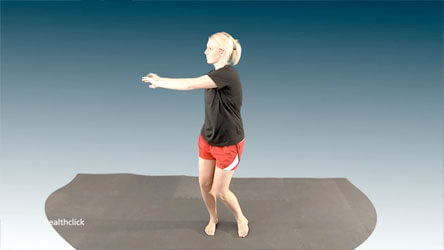
- Posterior View of the Biomechanical screen
- Anterior View of the Biomechanical screen
- Interpreting the Biomechanical screen
Examination of the Foot - Chapter 1 - Highlights
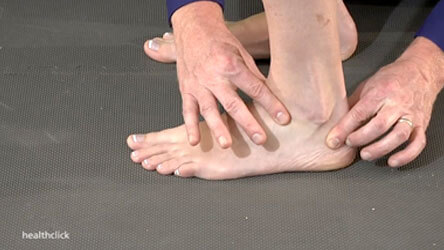
- Leg to rearfoot relationship in standing
- Assessing the axis of inclination of the subtalar articulation
- Prone biomechanical evaluation
- Leg to rearfoot bisection and passive inversion and everison assessment
- Measurement of STJN
- Finding Subtalar joint neutral: lateral hand placement
- Finding Subtalar joint neutral: medial hand placement
- Goniometric measurement of Dorsiflexion in Subtalar joint neutral
- Goniometric measurement of gross Dorsiflexion
- Open chain manual muscle testing of the foot and ankle musculature
- Assessing accessory motion testing of the longitudinal midtarsal joint
Examination of the Foot - Chapter 2 - Highlights
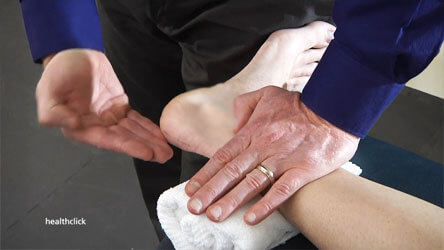
- Assessing Longitudinal Midtarsal joint accessory motion: A normal example
- Assessing Oblique Midtarsal joint accessory motion
- Differential Diagnosis: What the book doesn't say
- Key palpatory findings in foot and ankle differential diagnosis-summary
- Differential diagnosis and palpatory findings for heel pain syndrome
- Differential diagnosis and palpatory findings for plantar fasciitis/plantar fasciosis
- Differential diagnosis of fat pad atropy
- Differential diagnosis and palpatory findings for entrapment of the first branch of the lateral plantar nerve
- Static Gastroc stretching with Internal rotation
- Static Soleus stretching with Internal rotation
- Open chain stretching of the posterior leg
Treatment of the Foot - Chapter 1 - Highlights

- Static Gastroc stretching with Internal rotation
- Static Soleus stretching with Internal rotation
- Open chain stretching of the posterior leg
- Open chain stretching of the intrinsic muscles of the foot
- Tri-planar stretch of the posterior hip and Iliotibial band
- Tri-planar stretch of the gastroc-soleus complex
- Overview of options for open chain strengthening with an ankle isolator
- Resisted open chain strengthening of the posterior calf musculature
- Resisted open chain strengthening of the lateral ankle
- Resisted open chain strengthening of the medial ankle
- Resisted open chain strengthening of the solues
Treatment of the Foot - Chapter 2 - Highlight

- Resisted open chain strengthening of the pretibial musculature
- Resisted open chain intrinsic or long flexor muscle strengthening
- The nose reach exercise
- Eccentric heel rises: 2 up/1 down
- Functional training of the foot intrinsic musculature
- Rotational lunges
- Posterior Medial reach
- Lateral lunges
- Monster walk
- Single limb squat
- Pistol Squat
Treatment of the Foot - Chapter 3 - Highlights

- Grade I to Grade IV posterior to anterior mobilization of the Talocrural joint
- Birdseye view of mobilization in the appropriate plane of the talocrural joint
- Mobilization of the talocrural joint to improve plantarflexion
- Mobilization of the distal tibiofibular articulation (distal syndesmosis)
- Graded mobilization of the Subtalar joint on the medial aspect
- Graded mobilization of the Subtalar joint on the lateral aspect
- Instrumented soft tissue mobilization (IASTM) to the plantar foot
- Lower extremity alignment pre and post correction (Before)
- Lower extremity alignment pre and post correction (After)
- Assessment of orthotic function via Dynamic balance testing
Treatment of the Foot - Chapter 4 - Highlights
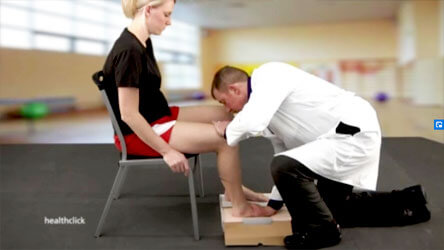
- Orthotic casting via a partial weight bearing foam crush box
- Orthotic casting via negative suspension slipper casting technique-the application
- Orthotic casting via negative suspension slipper casting technique-the product
Course Test - Evaluate your knowledge

- Use the Healthclick proprietary online education system which provides the online student with:
- Worldwide access to high definition video, anatomical animations and images, and written information
- The highest quality film in the industry, you can see the difference!
- Stop and resume within a course, the Healthclick system will optimize your course based on your device, connection and remembers where you left off.
- Real-time course updates. We are always adding to each courses, updating content, adding animations, these are not static courses!
- Evaluate your knowledge with the course test on any device.
- Print your state course certificate for CE credit.
- Take the online test as many times as need in order to achieve a 70 % or greater score.
Responsible CME® - Online CEU Course Testimonials
67.225.255.111The course material is clear, concise and provides intermediate to advanced skills for the clinician. -- Julius, Physical Therapist
Excellent course. Videos were very descriptive but to the point with emphasis on proper hand placement and technique. Differential diagnosis portion was excellent! -- Angela, PT
This course provides a great overview of foot/ankle anatomy and treatment, along with valuable tools to use in the clinic. -- Jeremy, PT
Great Value -- David, PT
This course provided a good assessment of the foot and ankle for orthotic development. Able to begin providing this service after some practice. -- Nicholas, PT
I found this course to be informative on the foot and its motion. I look forward to using these techniques. -- TERESA, PTA